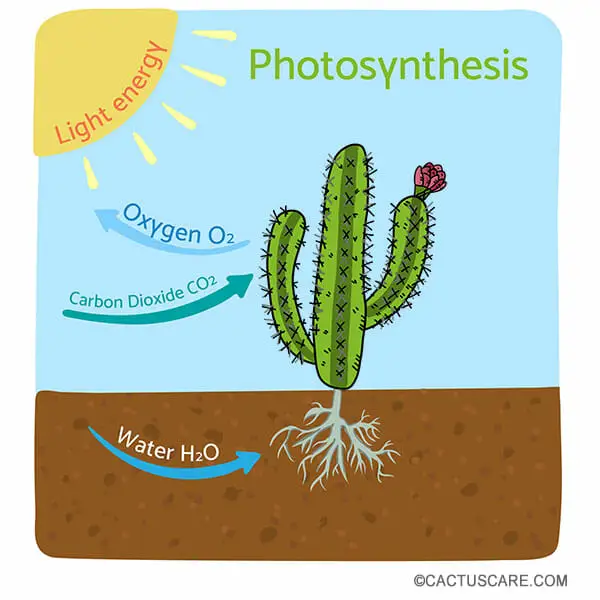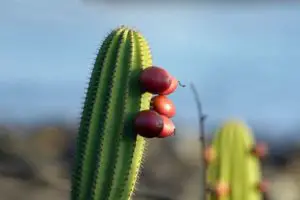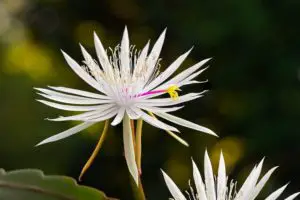Strange as they might look in comparison, cacti are still plants.
But without leaves, how do cacti perform photosynthesis?
Cacti perform photosynthesis using adaptations to their environment, like crassulacean acid metabolism and sturdy green stems.
But since photosynthesis is a complex process, it’s not quite as simple as just turning a stem green.
Here’s what you need to know about cactus photosynthesis.
What Is Photosynthesis?

Before you can really understand why cacti are different, you have to know a little bit about what photosynthesis is and why plants use it. Like all living things, plants need certain complex molecules to fuel their metabolism.
That’s what allows them to grow and reproduce.
Simple molecules, like water, can be absorbed directly from the environment, but others, like sugars, are too large and complicated to absorb.
Even if they weren’t, it would be tricky for plants to find exactly the types of sugar they need present in their environment all the time.
So instead, they opt to build their own using three basic ingredients: carbon dioxide, water, and light.
The Ingredients For Plant Food
The carbon dioxide required for photosynthesis serves as a source of carbon.
Carbon is considered the building block of the natural world.
It is an element that forms the main ingredient in all the sugars a plant makes, and just about every other part of the plant as well!
Plants get their carbon dioxide from the surrounding air, which is why trees and other plants are considered a big part of helping remove excess carbon dioxide from our atmosphere.
Water is absorbed into the plant primarily through the roots, and is broken apart into its component atoms—hydrogen and oxygen—to serve as a source of chemical energy for the actual synthesis process.

Water is also a source of hydrogen, which is the other main ingredient in sugar.
Light energy is absorbed into plants through their chloroplasts.
Since most plants grow in well lit areas, they can afford to be a bit picky about what kinds of light they use for this process.
Certain wavelengths of light work better in photosynthetic reactions than others, so those wavelengths are absorbed.
Those that don’t work well—typically those in the green range of light—are reflected, which is why plants in general and chloroplasts in particular look green.
Plants that live in less sunny areas can’t be quite as picky.
That’s why you’ll see shade dwelling plants that are dark green rather than bright green, and why some deep-dwelling sea plants are almost black.
They absorb more wavelengths of light and reflect back very little.
Putting It All Together
With all three ingredients on hand, plants can go to work assembling the sugars they need.
The light energy breaks down the water and creates chemical energy. This in turn is used to split apart the carbon dioxide into carbon and oxygen.
The oxygen is released back into the environment while carbon and hydrogen are combined to make something new: glucose!
This simple sugar is not only delicious, it’s also the basic building block for everything a plant does.
It can be converted into a tough, durable molecule called cellulose, which forms the cell walls of the plant and allows it to continue to grow.
Glucose can also be used in the plant’s other metabolic processes, providing energy to the plant’s cellular machinery just like it does in our own bodies.
And, if there’s too much glucose, the plant can also store it for later in the form of more complex sugars, like starch.
If the plant runs into hard times, it can draw on these stored resources to keep from dying.
Why Cacti Perform Photosynthesis Differently

So that’s the basic idea of what photosynthesis is and why it’s necessary for plants to survive.
It’s clearly working pretty well, since plants are among the most abundant organisms on earth.
So why would cacti need to do it differently? In short, because deserts are harsh.
Desert-dwelling plants have to be tough.
The baking sun and lack of water alone would be enough to kill most plants. Throw in the occasional marauding animal looking for a tasty snack, and it’s just about impossible to survive. Unless, of course, you’ve adapted.
Soft, broad leaves might be good at photosynthesis, but they lose a lot of water due to evaporation.
Over time, cacti modified them into clusters of sharp spines or hairs.
These new leaves were good at two things: avoiding water loss and protecting the plant (On this topic, I wrote a post on why cacti adapted to have spines instead of leaves).
They were useless when it came to photosynthesis, though, so instead, the stems of the cacti were put to work.
Unlike many large plants, the stems of cacti are usually green with chlorophyll, indicating that this is where photosynthesis is taking place.
How Cacti Hold Their Breath During The Day
A large stem can still lose a lot of water if the plant isn’t careful.
The biggest reason for water loss is transpiration, or evaporation from the leaves or surface of the plant.
Some transpiration is necessary, because this is what draws water up from the plant’s roots.
But too much can cause the plant to shrivel and die. Most of the water is lost through pores in a plant’s leaves called stomata.
These pores are also where the plant releases the oxygen it creates during photosynthesis, and takes up the carbon dioxide in needs to continue building sugars.
Leaving the stomata open during the heat of the day drastically speeds up the loss of water, so instead, cacti hold their breath until evening.

Once the sun sets and the desert begins to cool off, the risk of evaporation is lessened.
Cacti open the stomata in their stems and start to take in carbon dioxide.
For most plants, this is the point at which the carbon dioxide molecules would be fed straight into the photosynthesis process, but there’s just one problem—it’s dark out!
With no light energy to drive the process, cacti have to store their carbon dioxide until dawn, at which point they can begin to photosynthesize as usual.
All About Crassulacean Acid Metabolism
The carbon dioxide molecules are stored in the form of malic acid, which is part of the reason this unusual adaptation is called Crassulacean Acid Metabolism, or CAM.
The “crassulacean” part of the name comes from the name of the family of plants in which the process was first discovered.
They’re called the stonecrops, or, more scientifically, Crassulaceae.
CAM is used by lots of different types of plants, especially those that live in resource-poor environments.
Most desert-dwellers use some form of CAM, whether all the time or just when water is particularly tight.
Other types of plants, including some aquatic ones, use CAM to conserve carbon dioxide instead of water.
In environments that have little carbon dioxide, it makes sense to gather and store as much as possible for later use. CAM to the rescue!
There’s also an unusual side-effect of CAM that’s especially important for anyone harvesting cactus for food.
Because the time of day greatly affects the chemical composition of the plant, it will also affect the taste!
Acids taste sour (think of the acid in vinegar). Cactus that’s harvested late at night or early in the morning will have a higher concentration of malic acid in its flesh, and so will taste sour.
By the afternoon, though, that acid will have been converted into sugar, so that same plant harvested later in the day would taste much sweeter.
Who’d have thought the way a plant performs photosynthesis could have such an effect?
Photosynthesis might be a complicated process, but the reason why cacti and other desert-dwelling plants do it differently is simple: they have to!
The adaptations they’ve gained over time are perfect for keeping water in and the hot, dry air out.
It’s yet another feature that make cactus plants so fascinating and unique.
What are your favorite unique cactus traits or varieties? Share in the comments below!



Beautifully explained & very useful for academic use
Great Info!!!!!!!!!!!!!!!!!!!!!!!!!!!!!!!!!!!!!!!!
Can we lessen the chlorophyll of the cacti? I am just wondering why cati have lots of variegated species. Can you explain how does this happen?
Can we Actually Have info of their Photosynth